Wildflowers of the Adirondacks:
White Water-lily (Nymphaea odorata ssp. odorata)
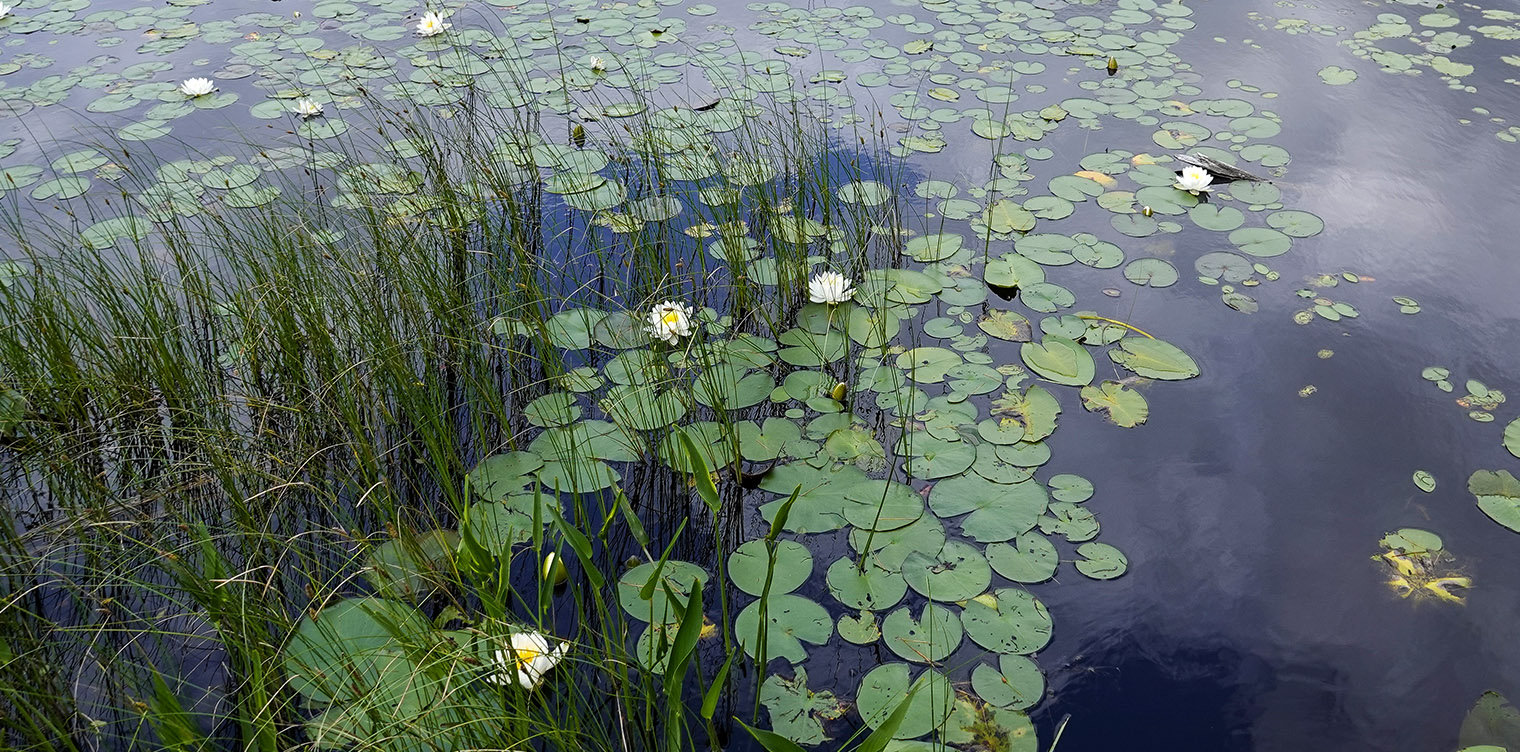
White Water-lily (Nymphaea odorata ssp. odorata) is an aquatic wildflower which produces showy white flowers in early summer in marshes, ponds, and other wetlands in the Adirondack Mountains of upstate New York.
This plant is part of the family Nymphaeaceae, which consists of two genera.
- The genus Nuphar has four species, including the Yellow Pond Lily (Nuphar variegata) – another aquatic plant commonly seen growing in the Adirondacks in the same habitat as White Water-lilies.
- The plant of interest here (White Water-lily) is part of the second genus: Nymphaea. The subspecies that grows in our area is Nymphaea odorata ssp. odorata. There is another subspecies – Tuberous White Water Lily (Nymphaea odorata ssp. tuberosa), but it does not occur in the Adirondacks. Authors disagree on how these two subspecies should be categorized.
The genus name (Nymphaea) is a reference to water nymphs, evoking the plant's watery habitat. The species name (odorata) derives from the fragrance of the flower.
Other common names for this plant include Water Lily, Waterlily, White Water Lily, White Waterlily, American White Waterlily, American White Water-lily, Fragrant Water-lily, Fragrant White Water Lily, Fragrant White Water-lily, Sweet Water-lily, Sweet-scented Water Lily, and Sweet-scented White Waterlily. Many of these names include a reference to both the color and the fragrance of the flowers.
Identification of White Water-lily
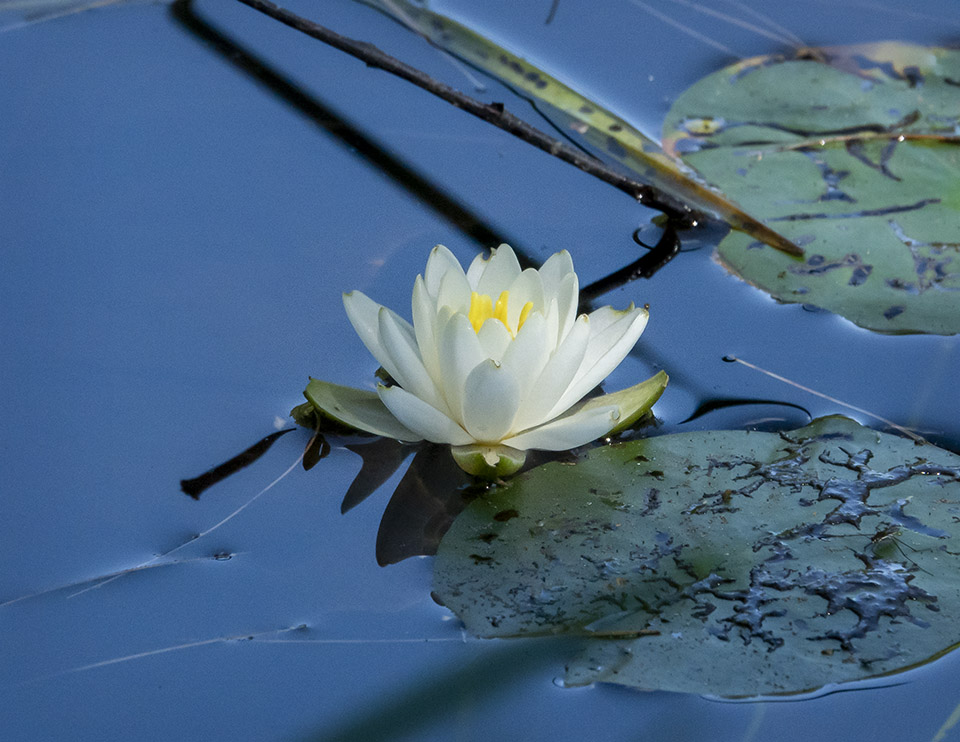
White Water-lilies are aquatic plants growing from a fleshy rhizome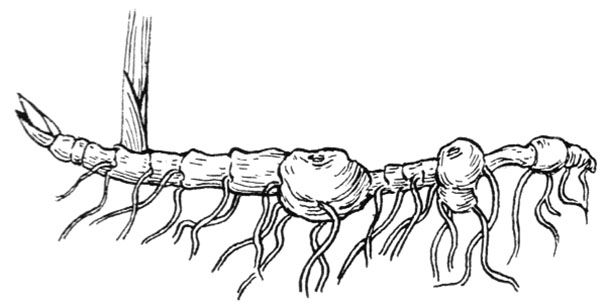 Rhizome: The modified subterranean stem of a plant that sends out roots and shoots from its nodes. Rhizomes are also called creeping rootstalks and rootstocks.. The plants can form dense colonies in shallow water, sometimes completely covering the surface of the water with leaves.
Rhizome: The modified subterranean stem of a plant that sends out roots and shoots from its nodes. Rhizomes are also called creeping rootstalks and rootstocks.. The plants can form dense colonies in shallow water, sometimes completely covering the surface of the water with leaves.
The leaves of White Water-lily float on the surface of the water. They are nearly circular with a deep slit at the base. The leaves are four to ten inches in diameter, with smooth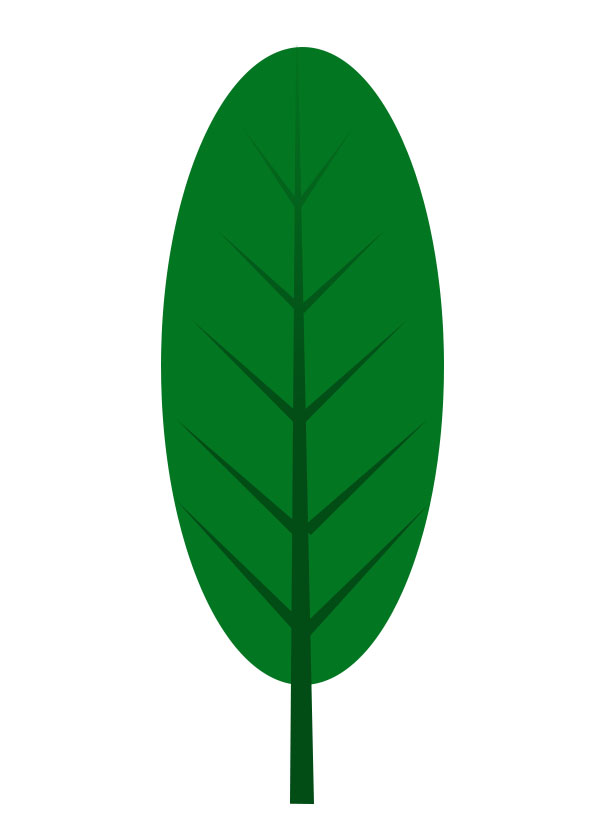 Smooth leaf edges do not have any teeth. marginsThe structure of the leaf's edge., meaning that the edges of the leaves are not toothed
Smooth leaf edges do not have any teeth. marginsThe structure of the leaf's edge., meaning that the edges of the leaves are not toothed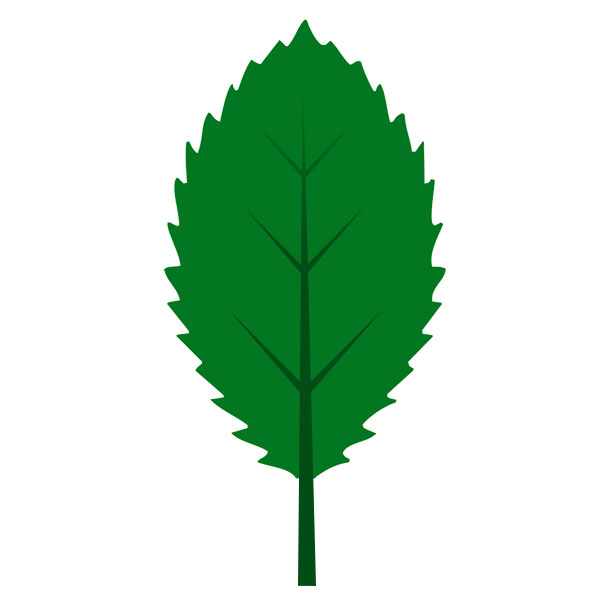 Toothed: Leaves which have a saw-toothed edge.. The upper surface of the leaf is green and somewhat glossy, while the underside is often purplish.
Toothed: Leaves which have a saw-toothed edge.. The upper surface of the leaf is green and somewhat glossy, while the underside is often purplish.
White Water-lily flowers have twenty to thirty white tapering petals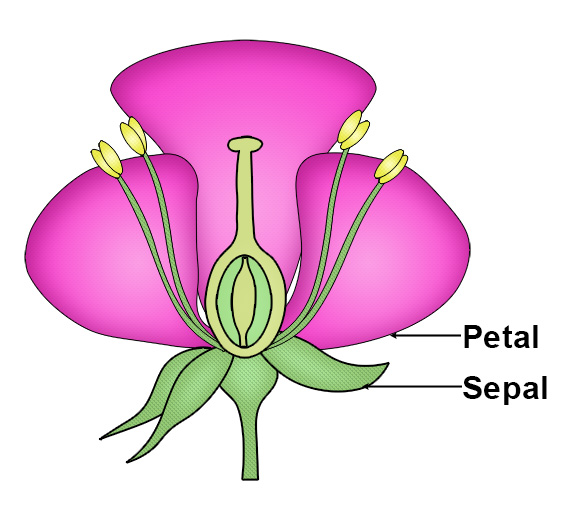 Petals: Modified leaves that surround the reproductive parts of flowers. Petals are often brightly colored or unusually shaped to attract pollinators.. They also have forty or more bright yellow stamens
Petals: Modified leaves that surround the reproductive parts of flowers. Petals are often brightly colored or unusually shaped to attract pollinators.. They also have forty or more bright yellow stamens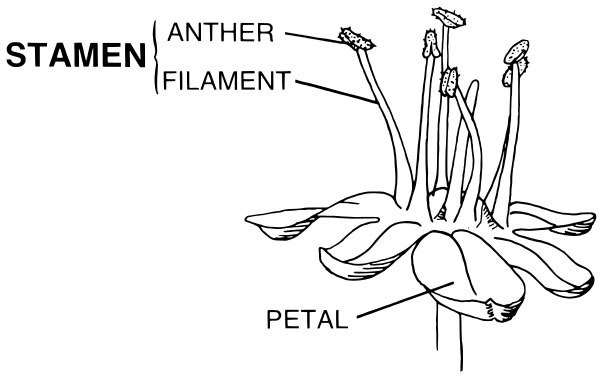 Stamen: The male part of the flower, made up of the filament and anther. in the center and a whorl of four green to purplish sepals
Stamen: The male part of the flower, made up of the filament and anther. in the center and a whorl of four green to purplish sepals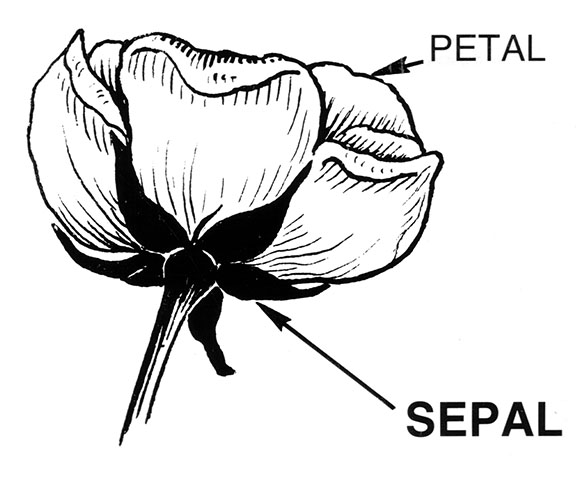 Sepal: One of the usually separate, green parts that surround and protect the flower bud and extend from the base of a flower after it has opened. at the base. The flowers, which are three to five inches wide, are fragrant and (like the leaves) float on the surface of the water. The flowers are usually open in the morning, but typically close by mid-afternoon and remain closed at night.
Sepal: One of the usually separate, green parts that surround and protect the flower bud and extend from the base of a flower after it has opened. at the base. The flowers, which are three to five inches wide, are fragrant and (like the leaves) float on the surface of the water. The flowers are usually open in the morning, but typically close by mid-afternoon and remain closed at night.
In the Adirondack Park, White Water-lilies typically bloom from early summer through August. A tally for the upland Adirondack areas compiled by Michael Kudish, based on data collected from the early seventies to the early nineties, indicates that the White Water-lily was in flower from 18 July to 21 August, with a median bloom date of 27 July. Data from more recent years suggests somewhat earlier bloom times, starting in late June.
The fruit of White Water-lily is spongy, berry-like and green. It contains oval seeds with structures that facilitate dispersal by water.
Uses of White Water-lily
Although the young leaves of White Water-lily reportedly can be boiled and served as a vegetable, the main human use of this plant appears to have been medicinal. Native Americans used it as a herbal remedy for a variety of ailments, including colds, tuberculosis, bronchial complaints, toothaches, and mouth sores.
Wildlife Value of White Water-lily
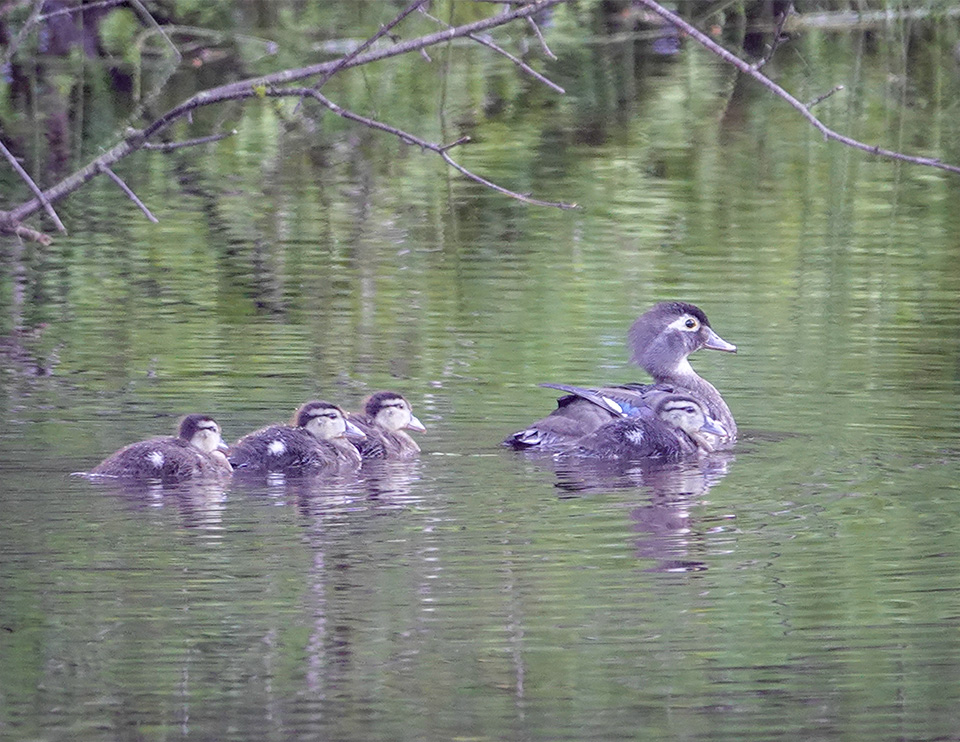
White Water-lily is of significant value for a variety of wetland-dwelling wildlife, both directly as a food source and indirectly as an important part of wetland ecology. The plant's flat, floating leaves comprise one of the most populous micro-habitats in the pond environment, providing resting platforms for dragonflies and damselflies.
White Water-lily is a food source for a number of insects. The abundant pollen of the flowers attracts a wide variety of insects, including bees, flies, and beetles.
- Other insects, such as Waterlily Thrips and Water Lily Leafcutters, feed on the leaves and petioles.
- The larvae of Water Lily Beetles and Waterlily Leaf Beetles feed on either the pollen or the leaves. Adult Waterlily Leaf Beetles relish the leaves.
- Water Lily Planthoppers reportedly eat any part of the plant that sticks up above the water line.
The seeds of White Water-lily provide a food source for several bird species. Wetland birds that consume the seeds include Wood Ducks, Common Goldeneyes, American Black Ducks, Lesser Scaups, and Sandhill Cranes.
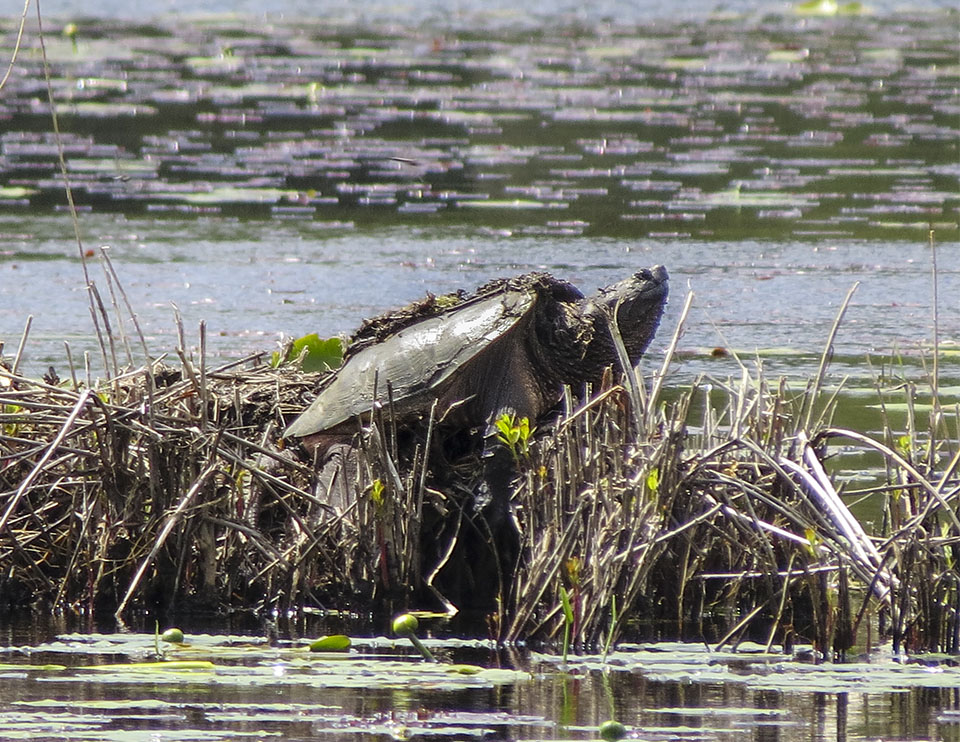
White Water-lilies are also important to wetland-dwelling amphibians and reptiles. Snapping Turtles reportedly use the plants as both food and cover. The seeds of White Water-lily are also consumed by Painted Turtles, although they make up only a minor component of their diet.
Mink Frogs are usually found in environments where there are many White Water-lilies, since they use them as protection from predators. They also feed on the spiders, snails, dragonflies, and beetles found on the lily pads.
Mammals, too, feed on this plant. The rhizomes reportedly are frequently eaten by Muskrats; this plant is said to be one of their major foods. The plant is said to make up five to ten percent of the diet of the largest of the Adirondack's rodents, the American Beaver. White-tailed Deer sometimes wade into the water to feed on White Water-lily foliage. Waterlily pads are also said to be a principal item in the summer diet of Moose.
Distribution of White Water-lily
Sources differ on the distribution of White Water-lilies, in part because of difficulties in distinguishing the two different subspecies. Our subspecies of White Water-lily (Nymphaea odorata subsp. odorata) is found mainly in the eastern parts of the United States and the southern regions of Canada's eastern provinces, with some populations in the western parts of the US and Canada (including Oregon, Washington, Idaho, and British Columbia).
In New York State, our subspecies is found in most counties in the eastern two-thirds of the state, plus some of the south western counties. White Water-lilies occur in all counties within the Adirondack Park Blue Line.
Habitat of White Water-lily
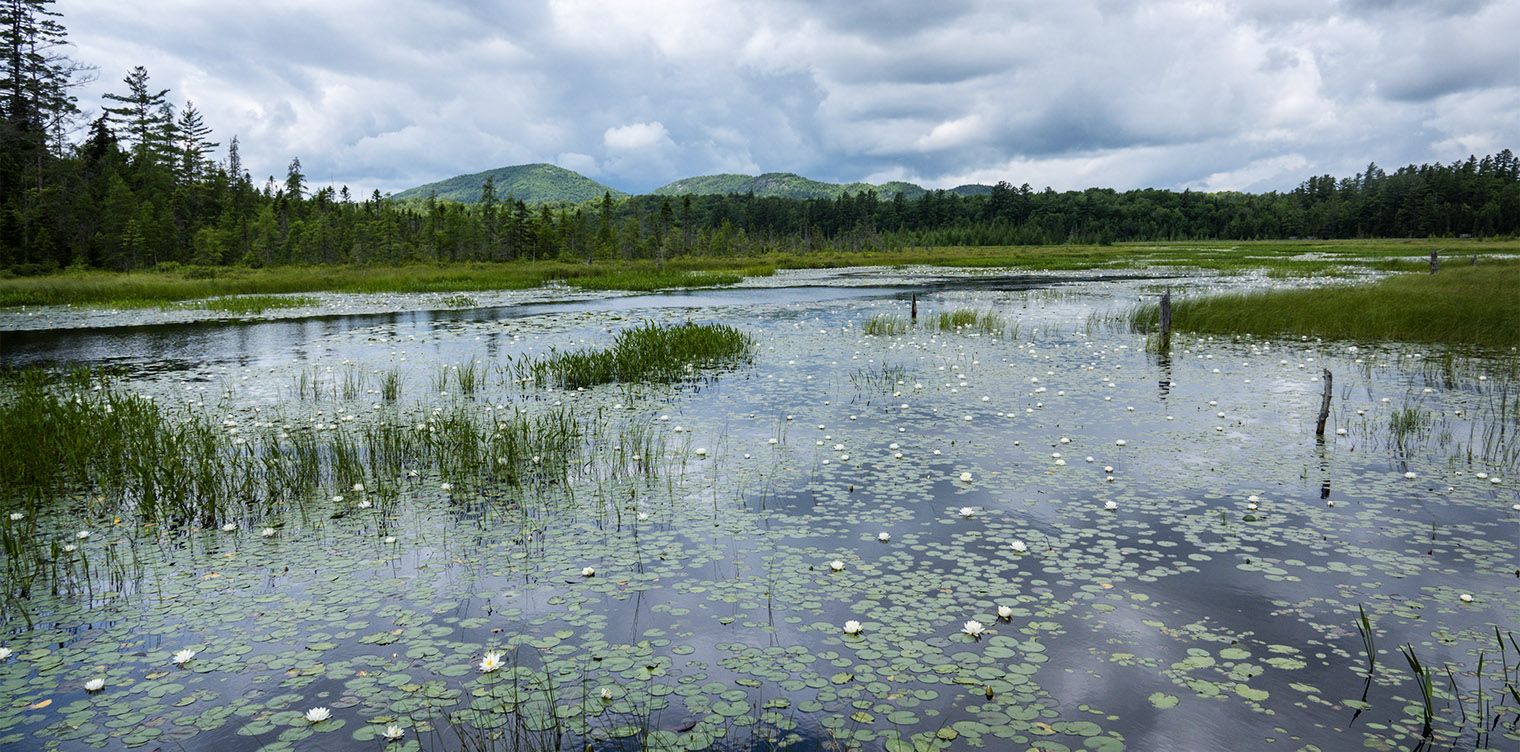
White Water-lilies are aquatic plants that can be found in marshes and slow-moving streams, as well as along the shallow edges of lakes and ponds. This plant can grow in water depths up to about five or six feet.
In the Adirondack Mountains, White Water-lilies are found in several wetland ecological communities:
- Bog Lake/Pond
- Deep Emergent Marsh
- Eutrophic Pond
- Marsh Headwater Stream
- Oxbow Lake/Pond
A Deep Emergent Marsh, for instance, is a marsh community flooded by waters ranging from six inches to 6.6 feet.
- In the shallower areas, emergent aquatic plants, such as Pickerelweed and cattails, flourish.
- Floating-leaved aquatic plants, including White Water-lily and Yellow Pond Lily, are found in somewhat deeper water.
- Characteristic birds in this ecological community include Swamp Sparrow, Red-winged Blackbird, and American Bittern.
- Characteristic amphibians and reptiles include American Bullfrogs, Snapping Turtles, and Eastern Painted Turtles. American Bullfrogs are heard more often than seen; listen for their deep bass bellows. Snapping Turtles, who spend most of their time in water, are most often seen when they move ashore in search of suitable nesting spots. Look for Eastern Painted Turtles basking in the sun in the reeds on the margins of the water.
One of the most convenient places to observe White Water-lilies is on Heron Marsh at the Paul Smith's College VIC. The Heron Marsh Trail features several overlooks that provide close-up views of this plant, as does the floating bridge across Heron Marsh on the Woods and Waters Trail. White Water-lily can also be seen from the Black Pond Trail, in the slow-moving waters of the Black Pond outlet.
References
Michael Kudish. Adirondack Upland Flora: An Ecological Perspective (The Chauncy Press, 1992), pp. 23-28, 106.
New York Flora Association. New York Flora Atlas. Nymphaea odorata Aiton ssp. odorata. Retrieved 6 February 2018.
United States Department of Agriculture. The Plants Database. American White Waterlily. Nymphaea odorata Aiton ssp. odorata. Retrieved 6 February 2018.
Flora of North America. Nymphaea odorata subsp. odorata. Retrieved 6 February 2018.
NatureServe Explorer. Online Encyclopedia of Life. American Water-lily. Nymphaea odorata ssp. odorata. Retrieved 6 February 2018.
Margaret B. Gargiullo. A Guide to Native Plants of the New York City Region (New York City Department of Parks & Recreation, 2007), p. 122.
Native Plant Trust. Go Botany. White Water-lily. Nymphaea odorata Ait. Retrieved 17 December 2019.
New York Natural Heritage Program. 2019. Online Conservation Guide for Bog Lake/Pond. Retrieved 17 December 2019.
New York Natural Heritage Program. 2019. Online Conservation Guide for Deep Emergent Marsh. Retrieved 17 December 2019.
New York Natural Heritage Program. 2019. Online Conservation Guide for Marsh Headwater Stream. Retrieved 17 December 2019.
New York Natural Heritage Program. 2019. Online Conservation Guide for Oxbow Lake/Pond. Retrieved 17 December 2019.
New York State. Adirondack Park Agency. Preliminary List of Species Native Within the Adirondack Park Listed Alphabetically by Scientific Name and Sorted by Habit. Volume 1. Updated 10.23.2006, p. 61. Retrieved 26 January 2017.
USA National Phenology Network. Nature’s Notebook. Nymphaea odorata. Retrieved 7 February 2018.
Connecticut Botanical Society. Fragrant Water-lily. Nymphaea odorata Ait. Retrieved 7 February 2018.
University of Wisconsin. Flora of Wisconsin. Nymphaea odorata Aiton. Retrieved 7 February 2018.
Minnesota Wildflowers. Nymphaea odorata. American White Water-lily. Retrieved 7 February 2018.
Illinois Wildflowers. Fragrant Water Lily. Nymphaea odorata. Retrieved 7 February 2018.
Illinois Wildflowers. Vertebrate Animal & Plant Database. Nymphaea spp. Retrieved 7 February 2018.
Illinois Wildflowers. Plant-Feeding Insect Database. Nymphaea odorata. Fragrant Water Lily. Retrieved 7 February 2018.
Lady Bird Johnson Wildflower Center. American White Waterlily. Nymphaea odorata ssp. odorata. Retrieved 7 February 2018.
Anne McGrath. Wildflowers of the Adirondacks (EarthWords, 2000), p. 18, Plate 9.
Roger Tory Peterson and Margaret McKenny. A Field Guide to Wildflowers. Northeastern and North-central North America (Houghton Mifflin Company, 1968), pp. 6-7.
Doug Ladd. North Woods Wildflowers (Falcon Publishing, 2001), p. 199.
Lawrence Newcomb. Newcomb's Wildflower Guide (Little Brown and Company, 1977), pp. 358-359.
Meiyin Wu & Dennis Kalma. Wetland Plants of the Adirondacks: Herbaceous Plants and Aquatic Plants (Trafford Publishing, 2011), p. 153.
Donald D. Cox. A Naturalist's Guide to Wetland Plants. An Ecology for Eastern North America (Syracuse University Press, 2002), pp. 53, 67, 69, 132.
David M. Brandenburg. Field Guide to Wildflowers of North America (Sterling Publishing Company, Inc., 2010), p. 357.
Timothy Coffey. The History and Folklore of North American Wildflowers (FactsOnFile, 1993), pp. 6-7.
William Carey Grimm. The Illustrated Book of Wildflowers and Shrubs (Stackpole Books, 1993), pp. 90-91.
National Audubon Society. Field Guide to North American Wildflowers. Eastern Region. (Alfred A. Knopf, 2001), p. 642, Plate 61.
William K. Chapman et al. Wildflowers of New York in Color (Syracuse University Press, 1998), pp. 28-29.
Alexander C. Martin, Herbert S. Zim, and Arnold L. Nelson. American Wildlife & Plants. A Guide to Wildlife Food Habits (Dover Publications, 1951), pp. 451-452 .
John Eastman. The Book of Swamp and Bog: Trees, Shrubs, and Wildflowers of Eastern Freshwater Wetlands (Stackpole Books, 1995), pp. 203-209.
John Eastman, "American Black Duck," The Eastman Guide to Birds: Natural History Accounts for 150 North American Species. Kindle Edition. (Stackpole Books, 2012).
John Eastman, "Greater and Lesser Scaups," The Eastman Guide to Birds: Natural History Accounts for 150 North American Species. Kindle Edition. (Stackpole Books, 2012).
John Eastman, "Common Goldeneye," The Eastman Guide to Birds: Natural History Accounts for 150 North American Species. Kindle Edition. (Stackpole Books, 2012).
Plants for a Future. Nymphaea odorata - Aiton. Retrieved 7 February 2018.
Steven Foster and James A. Duke. A Field Guide to Medicinal Plants and Herbs of Eastern and Central North America. Third Edition. (Houghton Mifflin Harcourt, 2014), pp. 21.
Lee Allen Peterson. A Field Guide to Edible Wild Plants. Eastern and Central North America (Houghton Mifflin Company, 1977), pp. 22-23.
Bradford Angier. Field Guide to Edible Wild Plants. Revised and Updated. (Stackpole Books, 2008), pp. 8-9.
University of Michigan. Native American Ethnobotany. A Database of Foods, Drugs, Dyes and Fibers of Native American Peoples, Derived from Plants. American White Waterlily. Nymphaea odorata Ait. Retrieved 7 February 2018.
The Cornell Lab of Ornithology. Birds of North America. Subscription web site. Wood Duck, Common Goldeneye, Sandhill Crane, American Black Duck. Retrieved 7 February 2018.
Butterflies and Moths of North America. Watermilfoil Leafcutter Moth. Parapoynx allionealis; Waterlily Leafcutter Moth. Elophila obliteralis. Retrieved 8 February 2018.
Iowa State University. BugGuide. Megamelus davisi; Polypedilum braseniae; and Parapoynx allionealis. Retrieved 8 February 2018.
University of Wisconsin. College of Letters & Science Field Station. Waterlily Leaf Beetle (Family Chrysomelidae). 9 July 2013. Retrieved 8 February 2018.
University of Wisconsin. College of Letters & Science Field Station. Water Lily Leaf Beetle II (Family Chrysomelidae). February 14, 2017. Retrieved 8 February 2018.
University of Wisconsin. College of Letters & Science Field Station. Water Lily Planehopper (Family Delphacidae). March 11, 2014. February 14, 2017. Retrieved 8 February 2018.
University of Michigan. Animal Diversity Web. Lithobates septentrionalis. Mink Frog. Retrieved 8 February 2018.
Allen J. Coombes. Dictionary of Plant Names (Timber Press, 1994), pp. 126-127.
Charles H. Peck. Plants of North Elba (Bulletin of the New York State Museum, Volume 6, Number 28, June 1899), p. 76. Retrieved 22 February 2017.
Stephen H. Jenkins and Peter E. Busher, "Castor Canadensis," Mammalian Species, No. 120, pp. 1-8.
United States Department of Agriculture. Fire Effects Information System (FEIS). Alces americanus. Retrieved 30 March 2017.
United States Department of Agriculture. Fire Effects Information System (FEIS). Species Reviews. Ondatra zibethicus. Retrieved 30 March 2017.
United States Department of Agriculture. Fire Effects Information System (FEIS). Species Reviews. Castor canadensis. Retrieved 29 March 2017. Retrieved 29 March 2017.
Patrick D. Moldowan et al, "Diet and Feeding Behaviour of Snapping Turtles (Chelydra serpentina) and Midland Painted Turtles (Chrysemys picta marginata) in Algonquin Provincial Park, Ontario," Canadian Field Naturalist, Volume 129, Number 4 (December 2015), pp. 403-408. Retrieved 7 February 2018.
Donald J. Padgett, Jeffrey J. Carboni and Daniel J. Schepis, "The Dietary Composition of Chrysemys picta picta (Eastern Painted Turtles) with Special Reference to the Seeds of Aquatic Macrophytes," Northeastern Naturalist, Volume 17, Number. 2 (2010), pp. 305-312.
Carl H. Ernest and Jeffrey E. Lovich. Turtles of the United States and Canada. Second Edition (The Johns Hopkins University Press, 2009), pp. 113-137.
